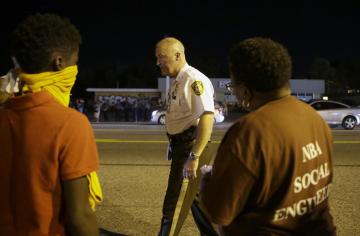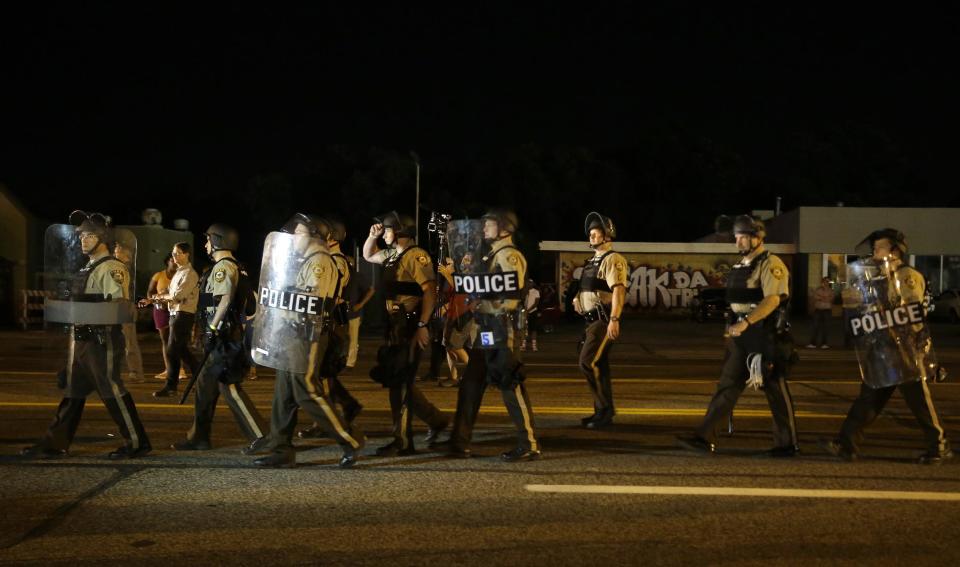How St. Louis police added Twitter to its arsenal

The St. Louis County Police Department’s Twitter feed was buzzing this week with moment-to-moment updates during protests commemorating Michael Brown’s death one year ago.
As Black Lives Matter demonstrators gathered in Ferguson, Mo., police officers provided a depth of coverage that almost resembled posts from local media outlets and citizen journalists.
This embrace of social media marks a shift in priorities for a police department that was relatively quiet last year when Ferguson officer Darren Wilson shot and killed 18-year-old Brown, sparking widespread outrage. At the time, the department had just one public information officer, Sgt. Brian Schellman. That’s not uncommon for a department its size, but it proved utterly insufficient in the wake of the countless emails and interview requests that inundated Schellman after Brown’s death.
“I think he was going on two or three hours of sleep a night, so they expanded the [county] department, which included opening up a social media position,” says Vera Culley, who was hired to handle the county’s social media accounts in November 2014.

Culley, an African-American Web producer with extensive journalism experience, says her goal was to tell the police department’s story, which she felt had gotten lost.
“There was no way in the world they were going to win on social media,” she says. “But there was no reason for them to not be in the conversation. My approach was to simply join the conversation. Make sure the facts were being reported as facts.”
St. Louis is not alone in awakening to the importance of social media in shaping the narrative of controversial events. Police departments across the nation are overhauling their public relations strategies.
With the ubiquity of smartphones, citizens can broadcast police actions around the world. This vigilance has the benefit of holding corrupt police accountable for their actions.
Chief Belmar, thank you for making it clear there is a difference between criminals & protesters@stlcountypd
— Patricia Bynes (@PatriciaBynes) August 10, 2015
But good cops, generally speaking, want the public to trust that they are being transparent, even if it means releasing information that casts their department in a less-than-favorable light. Nowadays, one of the best ways to establish this sort of reputation is by actively and swiftly supplying such information through social media.
St. Louis County’s online presence
In contrast to last August, Ferguson’s emphasis on a strong social media presence has been evident this week. In Ferguson’s emergency operation’s center (EOC), police and fire officials from many departments throughout St. Louis County monitored chat rooms, tweets, live streams on Periscope and other sources, while sharing updates by police radio.
“It was a big information-sharing center,” says Ericka Artz, who helps operate the EOC. “I think it benefits us because we have a more comprehensive picture of what is going on.”
Lt. Col. Troy Doyle, commanding officer for the department’s Division of Patrol, has been live-streaming videos using Periscope, an app released earlier this year, to provide an officer’s eye view of the streets of Ferguson. Several have said his commentary humanized the police.
Fascinating @periscopeco feed w/ @Tmann69. Not so much in terms of protest action, but his commentary. https://t.co/k1ezucSsTl
— Rachel Lippmann (@rlippmann) August 13, 2015
Police have also been responding to requests for information from the public and interacting with prominent civil rights activists like as Johnetta “Netta” Elzie of We the Protesters.

At 2:43 p.m. on Tuesday, Elzie asked her 68,400 Twitter followers to call Police Chief Jon Belmar to demand the release of protesters who had successfully shut down rush-hour traffic on Interstate 70 the day before.
By 3:18 p.m., the department tweeted in reply: “I-70 protesters with misdeamesnor [sic] charges are not in jail. They were not held. Thx.”
After gunfire erupted on Sunday night, police tweeted out pictures showing that two of their unmarked cars had been shot. They later shared a surveillance video of the suspect carrying a firearm.
The official St. Louis police Twitter account also provided updates about what officers were experiencing on the ground — some were pelted with rocks and bottles — as well as lamentations that some violent people were disrupting otherwise peaceful protests.
Unruly crowd is throwing frozen water bottles at officers. Those who choose to act violently will be arrested.
— St. Louis County PD (@stlcountypd) August 11, 2015
Their feed also issued warnings to demonstrators when police officers felt gatherings had turned violent and were no longer lawful — before making arrests. They asked commuters to avoid certain areas when protest activity was high.
Multiple verbal commands given up to this point; please follow the commands of the police department or you will be subject to arrest.
— St. Louis County PD (@stlcountypd) August 11, 2015
Chief Belmar spoke with protest leaders in an attempt to deescalate the situation. Protesters have moved to sidewalks.
— St. Louis County PD (@stlcountypd) August 11, 2015
“We’re such an on-demand society, and we want everything and we want it now. Well, there’s still a legal system,” Culley says. “There’s still a process we have to go through. So we can’t release everything.”
On the other hand, she added, if they are legally permitted to provide information, it’s often best practice to go ahead and share it with the public: With the 24-hour news cycle and social media, if there are blank spots in a story, people may speculate or invent details.
Protest activity is occurring in the West Florissant corridor. Streets may be impassible. Use an alternate route.
— City of Ferguson (@FergusonScoop) August 13, 2015
Preventing the spread of misinformation
Lauri Stevens, a social media strategist for law enforcement, says it is vital that police departments put out accurate information in a timely manner and are receptive to the public’s response.
In 2005, Stevens founded LAwS Communications to help law enforcement develop social media strategies. She has trained the Dallas Police Department, the U.S. Department of Justice’s COPS Office (which has been involved in the St. Louis protests) and the Toronto Police Department, among others.
Rumors can spread easily about high-profile cases, and if law enforcement keeps mum, misinformation can reach a point where it is widely accepted as fact and not easily corrected.
“The power of social media is so strong that it’s almost like perception is reality,” says Stevens. “It grows legs and gets bigger and bigger, and all of a sudden it’s what people believe and it’s not necessarily what happened.”

In November, just before St. Louis prosecutor Bob McCulloch announced a grand jury’s decision not to indict Wilson for Brown’s death, he blamed the 24-hour news cycle and social media for being the biggest challenges during the investigation.
“Within minutes [of Brown’s death], various accounts of the incident began appearing on social media, accounts filled with speculation and little, if any, solid, accurate information,” McCulloch said at the time.
Stevens, who has exclusively consulted with police since 2010, says the goal is not for law enforcement to have complete control of a story, but to have a voice once the story gets picked up by online activists and the media.
“That’s what you’ve seen in St. Louis County. Not in the beginning, but in the last several months they have kind of woken up to that,” she says.
On the other hand, online activists credit social media with directing the national conversation toward issues that they feel authorities have been able sweep under the rug.
Boston on establishing trust
Even police departments that have experienced an outpouring of goodwill and appreciation — like Boston’s following the marathon bombing of April 2013 — are embracing social media innovations.
The terrorist attack caused the Boston Police Department’s Twitter following to surge from about 60,000 to 320,000. Other agencies have learned from Boston’s social media tactics during the manhunt for the terrorists.
“We really all took a page from Boston’s [playbook],” Culley says.

After the manhunt ended, Boston’s following eventually tapered off to just below 200,000.
Lt. Mike McCarthy, who was tapped to run Boston’s public relations unit in November 2014, felt that they needed to revamp their approach to social media, using online platforms—notably Twitter, Facebook, and a blog—for public relations outreach in addition to news notifications.
“When there’s not an incident to report on, we didn’t want [our Twitter] to just sit dormant and stale. That’s when people start losing interest,” say McCarthy.
Four officers now run the Boston Police Department’s social accounts. They limit access so the small group knows exactly what is going out.+
McCarthy says it’s impossible for four people to know everything that’s going on in a 2,600-member police department spanning 11 districts and three specialized units, so they encourage officers to send updates from their days on the ground.
Their biggest hurdle, he says, was getting officers fully onboard, given the culture of law enforcement.
“Our first few months up here were spent reminding folks that we’re police officers like you and we want to make sure that people know what’s going on,” McCarthy said. “It’s not bragging if you tell me. Let me brag for you.” But the news isn’t always good.
Rachel McGuire, one of the four social media officers, says they strive for transparency and relaying accurate information quickly, even — perhaps especially — when it reflects poorly on the department.
“We are not afraid of a bad story, but we are afraid of an inaccurate story,” she says. “Social media allows us to put out what happens in our department, good and bad.”
The team found that pictures help grow interest, and they hope to start incorporating video, Vine and Periscope.
McGuire says they coined the slogan “#onelessgun” to accompany photos of illegal firearms that were taken off the street. Officers are asked to take pictures of the guns before sealing them in an evidence box, to send along with their police reports.
#OneLessGun BPD Officers Arrest 3, Recover 2 Firearms in 2 Separate Incidents http://t.co/JwNTt5ojeV pic.twitter.com/IdaJduvXgo
— Boston Police Dept. (@bostonpolice) August 9, 2015
“We can say, ‘This is what we’re doing out on the street. This is how much safer the streets are now,’” she says. “And the thing about social media is they can see it. We didn’t just get a gun off the street. They see the picture and say, ‘Oh, they got that gun.’”
Last year, during the frequent Black Lives Matter protests, McCarthy says his team always made sure to thank participants for expressing themselves peacefully and “doing themselves proud.”
“It encouraged cooperation and we got a lot of feedback about our role,” he says. “It was a tough year to be a cop. But at the end of it, we came out looking pretty good. That’s not by accident.”



